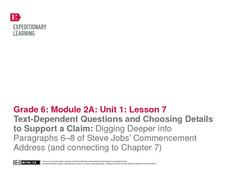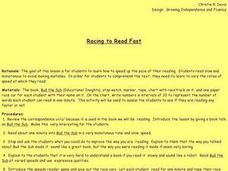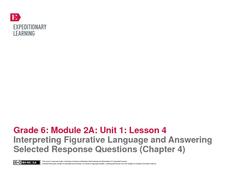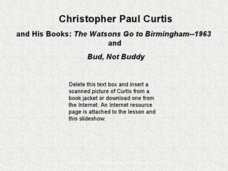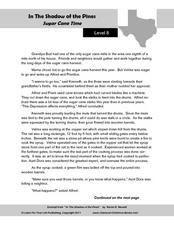Curated OER
Stick Out Your Tongue
Students explore their sense of taste and recognize good foods to eat. In this tasting lesson, students recognize that their tongue has taste buds for different types of tastes. Students create a bar graph showing their favorite taste (...
August House
The Ogre Bully
English language arts, math, science, dramatic arts, and cooking; this instructional activity has it all! In this multidisciplinary resource, your scholars will take part in a read aloud of The Ogre Bully by A.B. Hoffmire and have a...
Curated OER
What Is Your Favorite Place?
Good writing can come from personal places. Budding online authors read an excerpt from a narrative-style newspaper article and then respond to several related writing prompts. They compose blog responses that use vivid imagery to...
EngageNY
Text-Dependent Questions and Choosing Details to Support a Claim: Digging Deeper into Paragraphs 6–8 of Steve Jobs’ Commencement Address (and connecting to Chapter 7)
Readers learn how to choose specific details drawn from a primary source (Steve Jobs' 2005 Stanford University commencement address) to support an analysis of informative text.
Curated OER
Connect the Rhymes
If your budding readers are new to rhyme, this is a visual way to give them practice. They examine familiar sets of objects, matching them to their rhyming partners by drawing a connecting line. Practice left to right skills by asking...
Curated OER
Odd One Out
Which word doesn't rhyme? As they practice vowel-sound recognition, scholars examine rows of familiar objects to determine which object doesn't rhyme. There are four rows here, each with a beginning image and three subsequent images....
Curated OER
Slang and Dialogue in Bud Not Buddy
Students identify the 1930's slang in the novel, Bud, Not Buddy. They compare it to modern slang and rewrite a section of the book using modern slang instead of 1930's slang.
Curated OER
Racing to Read Fast
Students identify and interpret how to speed up the pace of their reading. Then they read slow and monotonous to avoid making mistakes. Students also read to comprehend the text that they need to identify to vary the rates of speed at...
Curated OER
Reading is Fun
Students explore the benefits and joys of reading. They review the reading comprehension strategy cross-checking. They then are introduced to the library and are encouraged to check out an independent book they would independently...
Curated OER
Fluency is Freedom!
Young scholars read orally in groups of two to increase reading speed and fluency in this lesson. They read provided books which emphasize the short vowel sounds. The pairs time each others reading and offer encouragement and support...
Curated OER
Reading With Speed
Students practice passages to increase their fluency. They work in pairs and time their peers for how long it takes to read sentences. They repeat the process three times and move to short text to continue practicing becoming a fluent...
Poetry4kids
Evoking the Senses in a Poem
Budding poets choose a topic for a sensory-filled poem. Authors describe that topic using detailed language based on the five senses. Then, switch the senses to create a fanciful poem intended to add a touch of fun to the objective.
EngageNY
Looking Closely at Stanza 3—Identifying Rules to Live By Communicated in “If”
Just as Bud, from the novel Bud, Not Buddy by Christopher Paul Curtis, had rules to live by, so does the poem, If by Rudyard Kipling, but how do the two relate? Pupils delve deep into the poem's third stanza, participate in a grand...
EngageNY
Pitching Your Claim with Best Evidence
Does Bud use his rules to survive or thrive? That is the driving question of a lesson plan following the reading of Bud, Not Buddy by Christopher Paul Curtis. In an argument essay prewriting activity, pupils use textual evidence to...
EngageNY
Writing: Drafting Body Paragraphs and Revising for Language
Begin the drafting phase of the writing process with a lesson plan focused on logically writing three body paragraphs. Then, revise the writing to make it more formal after a teacher-directed mini-lesson plan. Each paragraph highlights...
National Council of Teachers of English
Acrostic Poems: All About Me and My Favorite Things
Budding poets create two acrostic poems, one for their name and another using a word of their choice. Over the course of five days, scholars compose, revise, publish, and share their work with their peers.
Penguin Books
An Educator's Guide to The Green Glass Sea by Ellen Klages
A lot of secrecy shrouded the creation of the atomic bomb. Readers uncover some of that secrecy using an educator's guide for the novel The Green Glass Sea. Three weeks of lesson plans feature discussion questions and reading...
EngageNY
Text-Dependent Questions Text-Dependent Questions and Making a Claim: Digging Deeper into Paragraphs 12–14 of Steve Jobs’ Commencement Address (and connecting to Chapter 9)
Readers draw connections between Bud, Not Buddy and Steve Jobs' 2005 Stanford University commencement address and cite evidence from the two texts to support their analysis.
EngageNY
Interpreting Figurative Language and Answering Selected Response Questions (Chapter 4)
To prepare for an assessment of how well individuals are progressing with their ability to identify and analyze figurative language and its effect on tone and meaning, pairs work through Chapter Four of Christopher Paul Curtis'...
EngageNY
Planning for Writing: Introduction and Conclusion of a Literary Argument Essay
After completing three body paragraphs of an argument essay about life's rules to live by from Bud, Not Buddy Christopher Paul Curtis, it's time to begin writing the introduction and conclusion. Independently, pupils draft the final two...
EngageNY
End of Unit 2 Assessment: Final Draft of Literary Argument Essay
Take the last step in writing a literary argument essay using Bud, Not Buddy by Christopher Paul Curtis in an activity focused on feedback. Using the stars and steps revision method, pupils consider teacher and peer feedback to revise...
Alabama Learning Exchange
Christopher Paul Curtis
Introduce your readers to the famous author, Christopher Paul Curtis in this literature PowerPoint. They are introduced to the author, and two of his books: The Watsons go to Birmingham - 1963, and Bud, Not Buddy. This presentation would...
Curated OER
In The Shadow of the Pines: Sugar Cane Time
This resource provides a short reading passage, an excerpt from In The Shadow of the Pines by Karen K. Newell, about a family and their sugar cane harvest during the Great Depression. After the reading, there are four multiple choice...
Scholastic
Back from the Dead
If you could bring back one extinct animal, what would it be? That is the question your class will ponder. Your budding scientists read a passage, follow a cloning timeline, and review a diagram about the process of reviving a woolly...





